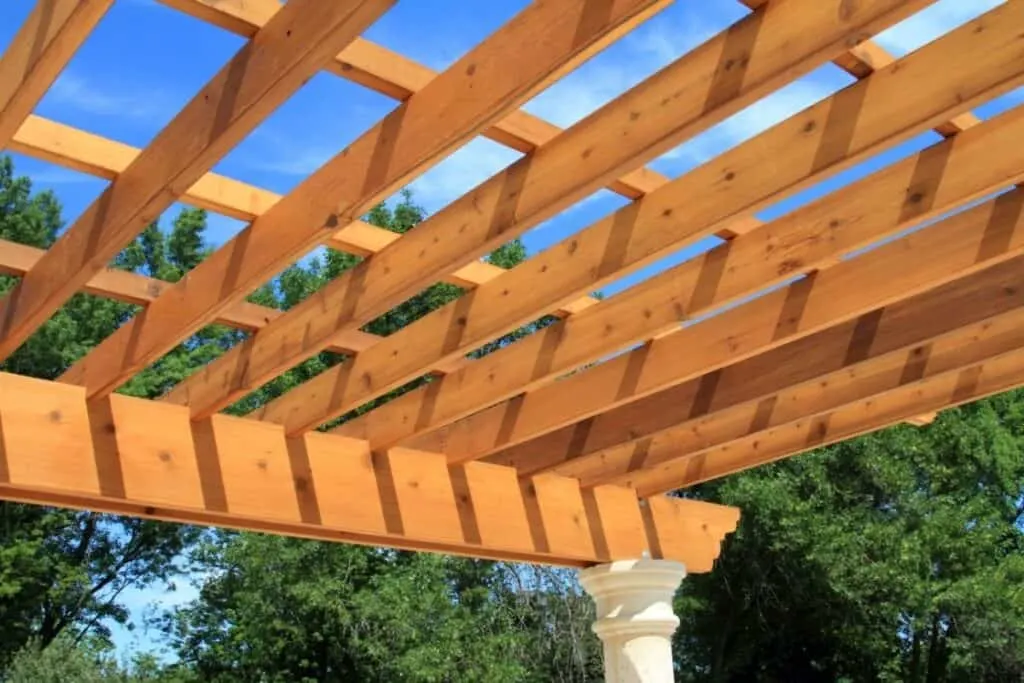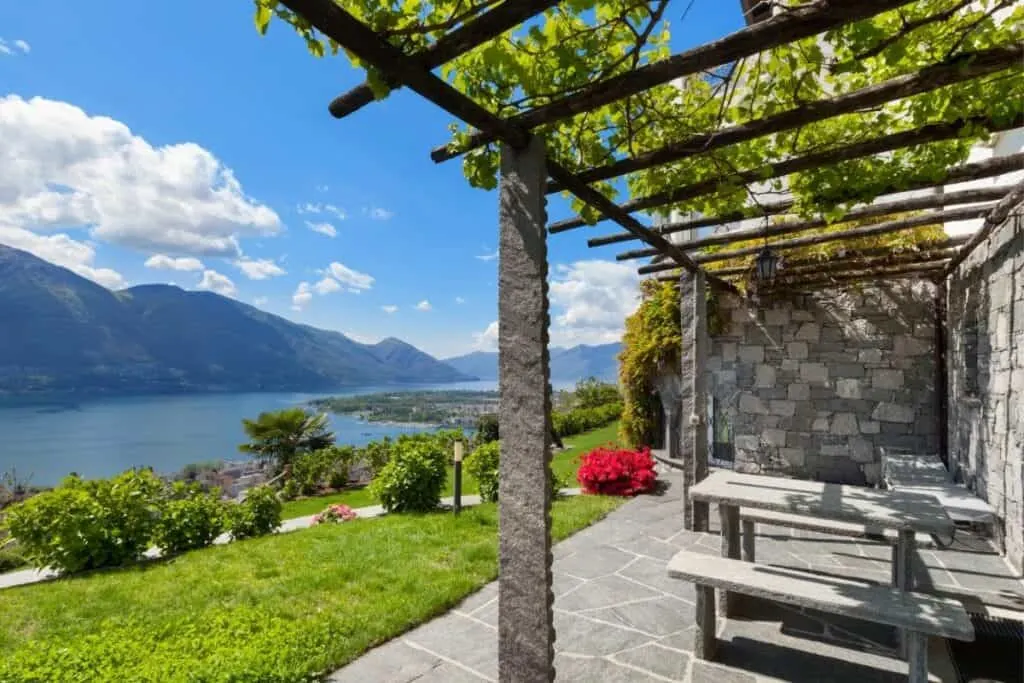Have you ever attempted to eat on a sunny patio without any cover and wished for a break from the hot sun? A pergola is one way to gain shade in a variety of outdoor areas and also works as a structure for training landscaping plants.
Pergolas come in all shapes and sizes, so it’s easy to get one that fits your space. You’ll also find several different designs so you can select one that suits your current landscaping and decor.
What is a Pergola?
Pergolas are a type of gazebo found in many gardens, outdoor areas, and decks. These structures feature posts at each corner and slats across the top for a roof that supports plant life, curtains, mesh, lattice, and more.
Pergolas feature a wide variety of materials, including wood, plastic, metal, and composite materials.
A pergola often covers a sitting or dining area, and with the addition of material along the top and sides, it can protect occupants from the weather.
What is the Point of a Pergola?
So, what is the point of a pergola?
Pergolas feature in many prominent gardens and outdoor spaces worldwide, and this structure is strong enough for training all kinds of woody vines and other plant life.
Pergolas provide shade and general protection from the weather, but this structure also serves as a trellis for various plants. Pergolas usually feature some kind of decorative element, so they look great in addition to providing function in your space. A pergola’s simple form also makes it an easy DIY project.
Pergolas frame walkways and provide cover to passageways and sitting areas. You may also see a pergola span between two pavilions or from the backdoor of a building to another feature. In some cases, a pergola stands alone within a space and serves as a designated area for a select activity such as dining, lounging, yoga, or meditation.

Why are Pergolas Not Covered?
You may be wondering, what is the point of a pergola without a cover?
Most pergolas don’t have a cover or top to them, allowing plants to grow up the posts and spread across the roof. It can take a while for plants to span this distance, even on a small pergola, but the effect can provide a dramatic element and shelter occupants from harsh sun, wind, and even some rain.
If you choose not to have plants covering the top part of your pergola, you can install a curtain or shade that pulls across and blocks out light. How much sun or other elements gets blocked depends purely on the type of curtain or shade you use.
Some pergolas have sides that span between the posts, and this offers excellent protection from the sun and wind. However, if you live in a somewhat windy or sunny area, putting upsides on your pergola might be more effective than a cover over the top, depending on what time of day you use the space and the placement of the pergola.
Do Pergolas Block the Sun?
Pergolas block some of the sun even without a cover on the top, but a cover or some plant life growing across them offers far better protection.
The slatted top of the pergola doesn’t block much of the sun on its own, but the corner beams and roof provide ample support and guidance for vining plants of all sorts.
If you want to maximize how much sun your pergola blocks out, consider its placement in relation to the sun during the time of day, you’ll be using it.
For increased sun protection, consider adding a curtain across the top or sides of the structure until plants have sufficiently covered this area.

Reasons to Own a Pergola
There are many reasons to own a pergola, and this classic structure can transform your backyard and add a bit of style to your current landscaping. Pergolas also help better define your space and create a higher level of definition between two areas of your yard.
A pergola can also provide a bit of privacy, protection from the elements, and general shade. You’ll also find many classic pergolas covered with plants, and this additional space is suitable for all types of climbing flowers and even some vegetables.
Adding a pergola can also add value to your home and make your landscaping more attractive for an affordable price. In addition, many homeowners find that pergolas combine well with other structures such as gazebos, trellises, latticework, and arbors so you can create a more custom feel.
Pergolas come in various materials, so you can easily find one in your budget that also matches your decor. You’ll also find that a pergola is the type of structure that a homeowner can install themselves despite their size.
When you add a pergola to your outdoor space, you get the bonus of having a designated place to entertain that is beautiful and unique. In addition, these structures lend themselves well to decors such as string lights, artwork, plant life, curtains, and many other accessories.
Pergolas vs. Other Outdoor Structures
So, what is the point of a pergola, and how is it different from other outdoor structures? When deciding between a pergola and structures like gazebos, trellises, carports, arbors, and latticework, it’s essential to take a close look at the function and the pros and cons involved.
Arbors don’t have the same columns that pergolas have at each corner, and they also tend to be on the smaller side. Arbors feature modern materials like vinyl more often than traditional wood, and they have a curved arch at the top instead of the flat roof on a pergola.
Pergolas are a type of gazebo, but a traditional gazebo has a rounded shape and a raised floor. Pergolas are also different from carports because they don’t usually provide storage for cars but can work for this task.
Trellises are accessories you can add to a pergola to help grow plants, and latticework is similar but often used as a material along the sides. Trellises and latticework aren’t particularly strong on their own, but some trellises have reinforcement that allows them to stand on their own.

Adding a Pergola to Your Landscape Design
Adding a pergola to your outdoor space is an excellent way to create more definition, but this structure also makes a statement. Therefore, it is crucial to get the correct size of a pergola and the type of material that suits your needs.
Consider where you place your pergola in relation to the sun, and if you live in an area where there’s saltwater nearby or frequent rain, you may want to consider a more robust top for the roof that keeps the water out.
It’s also worth considering curtains for your pergola to keep out the weather and provide privacy if you don’t want plants. You don’t have to get special curtains but measure carefully to ensure you get the correct size for a luxurious look.
Types of Pergolas
Pergolas feature a wide variety of materials, including:
- Metal
- Vinyl
- Wood
- Fiberglass
Most of the pergolas you’re likely to see feature wood or vinyl, and these materials provide durability, relatively easy assembly, and come in various finishes.
Most pergolas require some essential maintenance to look their best, and when cared for properly, they can last decades!
1. Metal
Metal pergolas tend to cost more than wood but less than fiberglass. Metal pergolas also require anchoring due to their lighter weight. Most metal pergolas feature aluminum construction, which doesn’t rust but can twist in significant winds.
If you live in a humid place or near the ocean, an aluminum pergola is a good option and comes in a wide array of color options.
2. Vinyl
Vinyl pergolas offer a clean look and virtually no maintenance, but you can clean them easily with a power washer. Vinyl performs well in humid climates and near saltwater and can last many years, provided it’s constructed with high-quality materials.
The one drawback to vinyl is that there are fewer colors to choose from, and most of the colors are white or close to white. This option is often a bit more expensive than wood, but it’s still a very affordable addition.
3. Wood
Wood pergolas are very common, and the beauty of this material is that you can stain or paint it to match your decor. Wood is a durable choice for pergolas, and it’s easy to clean using soap and water, a power washer, or some light sandpaper.
Wood pergolas also showcase the more traditional designs commonly associated with this structure through thick corner posts and a large timber roof. However, the rustic appeal of wood and the natural appearance makes this material perfect for enhancing an outdoor space at an affordable price.
4. Fiberglass
Fiberglass does not rust or corrode regardless of the weather conditions, but it is a more expensive option. Fiberglass also has a very long lifespan and is easy to paint, so you can easily change the color of your pergola.
This sturdy material lasts much longer than wood or vinyl, but there aren’t as many manufacturers who create these units, so you should expect longer lead times.


